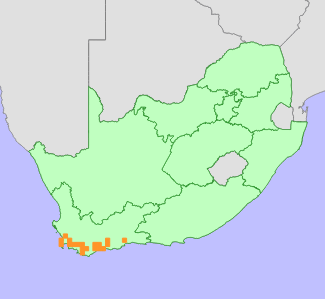|
Scientific Name | Elegia squamosa Mast. |
Higher Classification | Monocotyledons |
Family | RESTIONACEAE |
Synonyms | Elegia pectinata Pillans |
National Status |
Status and Criteria | Endangered A2c |
Assessment Date | 2012/07/11 |
Assessor(s) | N.A. Helme & L. von Staden |
Justification | A population reduction of at least 50% is estimated to have occurred in the past three generations of this long-lived resprouter (generation length 50 years) due to habitat loss. This formerly widespread (EOO 21 753 km²) species is now very rare, and remaining subpopulations are fragmented and isolated by extensive, ongoing habitat loss to crop cultivation, urban expansion and competition from alien invasive plants. |
Distribution |
Endemism | South African endemic |
Provincial distribution | Western Cape |
Range | Malmesbury to the Cape Peninsula, Bredasdorp and eastwards to Mossel Bay. |
Habitat and Ecology |
Major system | Terrestrial |
Major habitats | Peninsula Sandstone Fynbos, Swellendam Silcrete Fynbos, Cape Flats Sand Fynbos, Agulhas Sand Fynbos, Elim Ferricrete Fynbos, Potberg Ferricrete Fynbos, Garden Route Granite Fynbos, Western Coastal Shale Band Vegetation, Greyton Shale Fynbos, Overberg Dune Strandveld, Ruens Silcrete Renosterveld, Swartland Granite Renosterveld, Western Ruens Shale Renosterveld, Central Ruens Shale Renosterveld, Eastern Ruens Shale Renosterveld, Swartland Shale Renosterveld, Elgin Shale Fynbos |
Description | Seasonally damp clay flats and lower slopes with heavy soils. |
Threats |
| Past and ongoing expansion of crop cultivation has reduced this species' habitat by more than 80%. Urban expansion has also caused declines on the Cape Peninsula and around Stellenbosch. Competition from alien invasive plants are threatening a number of remaining subpopulations. |
Population |
Elegia squamosa is a formerly widespread species that has become very rare due to more than 80% habitat loss in the past 150 years. More than 60% of subpopulations known through historical records are now either locally extinct or in areas now extensively transformed, so that the species' persistence in these areas is uncertain. The large majority of subpopulations are now confined to small, isolated fragments and road verges. This species resprouts after fire, and is therefore estimated to be long-lived, with a generation length of at least 50 years. It is estimated based on loss of known subpopulations as well as the extent of habitat loss that there has been at least a 50% population reduction in the past three generations (150 years).
|
Population trend | Decreasing |
Assessment History |
Taxon assessed |
Status and Criteria |
Citation/Red List version | | Elegia squamosa Mast. | Least Concern | 2012.1 | | Elegia squamosa Mast. | Least Concern | Raimondo et al. (2009) | |
Bibliography |
Goldblatt, P. and Manning, J.C. 2000. Cape Plants: A conspectus of the Cape Flora of South Africa. Strelitzia 9. National Botanical Institute, Cape Town.
Linder, H.P. 1985. Conspectus of the African species of Restionaceae. Bothalia 15(3&4):387-503.
Linder, H.P. 2011. The African Restionaceae: an Interactive Key identification and description system. Version 6. http://www.systbot.uzh.ch/Bestimmungsschluessel/Restionaceae_en.html. Downloaded.
Raimondo, D., von Staden, L., Foden, W., Victor, J.E., Helme, N.A., Turner, R.C., Kamundi, D.A. and Manyama, P.A. 2009. Red List of South African Plants. Strelitzia 25. South African National Biodiversity Institute, Pretoria.
|
Citation |
| Helme, N.A. & von Staden, L. 2012. Elegia squamosa Mast. National Assessment: Red List of South African Plants version 2024.1. Accessed on 2025/12/08 |
 Comment on this assessment
Comment on this assessment


